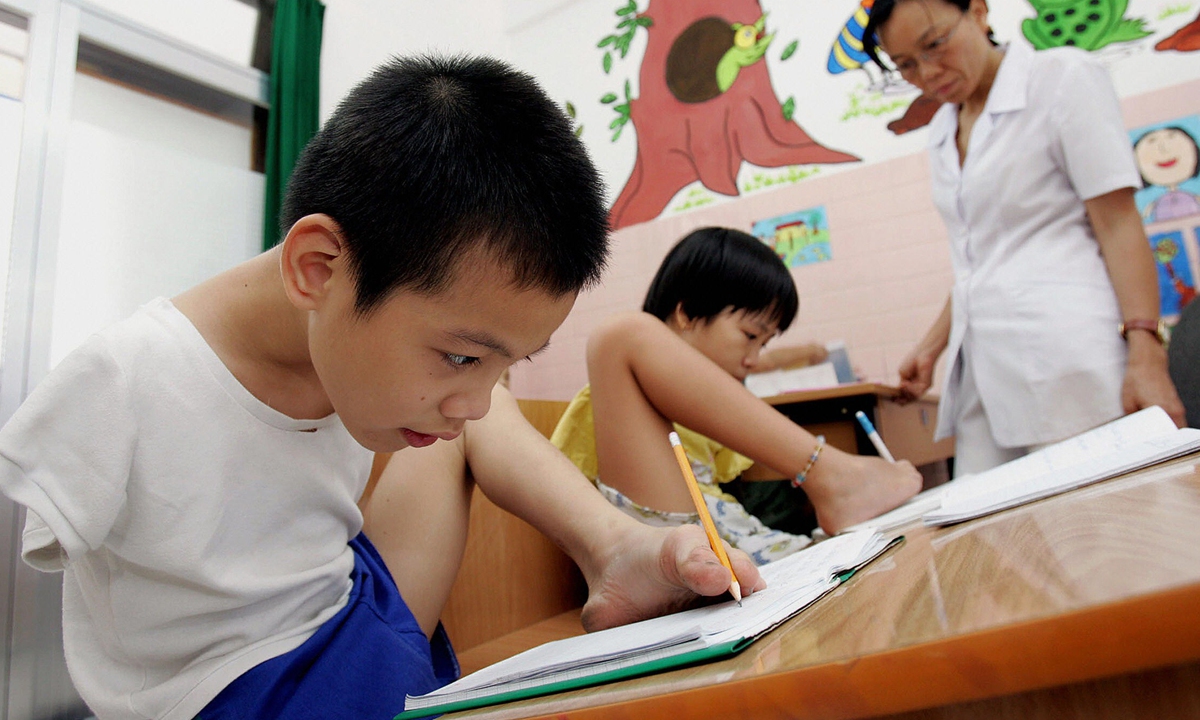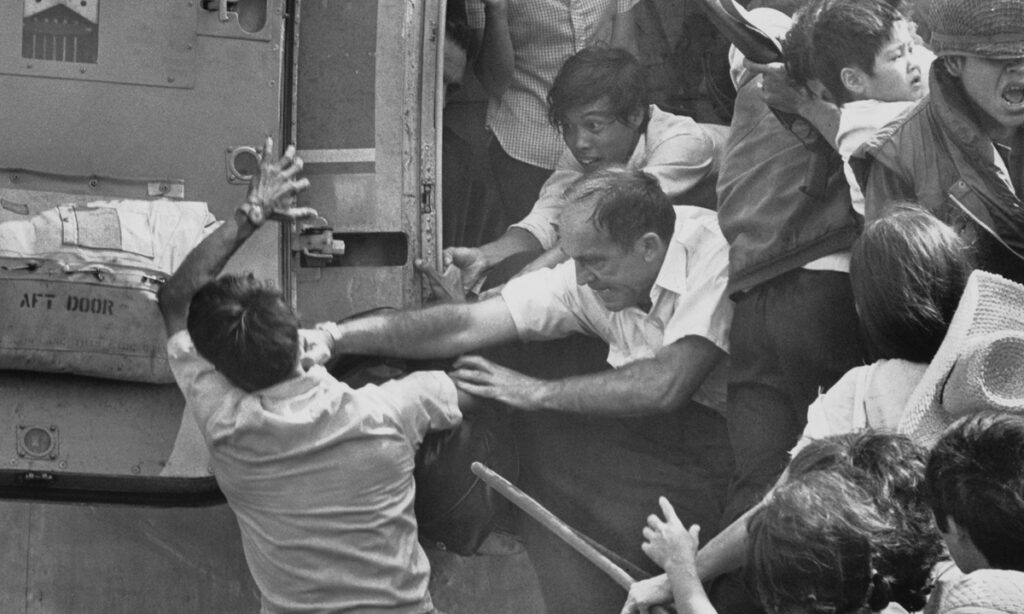Of the over 200 armed conflicts that have occurred in the world, from the end of World War II until 2001, more than 80 percent were initiated by the US. The wars did not bring a “better future,” but instead left behind a heap of mess. As reported in an article by TASS on the 20th anniversary of the 9/11 attacks, the only thing the US has done is to plunge occupied countries into complete chaos. The Global Times has launched a series focused on the chaos brought by the US’ retreat, harkening back to dark moments and memories through real history and stories.
The Vietnam War lasted for 20 years from 1955 to 1975, when the US went from its initial promise of “establishing a democratic regime” to the eventual tragedy of the “Saigon iron fist,” which not only struck hard at the hearts of Vietnamese people but also at the “faith” and “loyalty” of many who blindly trusted and idolized the US.
An American official punches a man in the face trying to pry him off the doorway of an airplane already overloaded with refugees seeking to flee Nha Trang, South Vietnam on April 2, 1975, according to The New York Times. Photo: VCG
The ‘Saigon iron fist’
In 1975, the city of Saigon in South Vietnam was captured by the People’s Army of Vietnam. This city was once the capital of the US-backed puppet regime of Vietnam and was later renamed Ho Chi Minh City. The “Fall of Saigon” is considered a landmark event marking the end of the Vietnam War.
In the final stages before the war ended, Americans in Vietnam evacuated in a panic while leaving the Vietnamese who had served them in a state of immense despair. They tried every possible means to evacuate with the Americans but were ruthlessly abandoned by their “allies.” A famous photograph called the “Saigon iron fist” captured this moment.
The Vietnam War lasted for about 20 years from 1955 to 1975. According to media reports, the US deployed up to over 500,000 troops to Vietnam during the conflict. As the war progressed, the promises made by the US kept changing, from initially promising to establish a “unified, freely elected democratic regime” in Vietnam to a “stable, free South Vietnam,” to eventually sanctioning a so-called “orderly withdrawal,” which in reality turned into a chaotic farce in the final hours.
In April 1975, the People’s Army of Vietnam closed in on Saigon, completely surrounding the city and destroying the airport. In just one day, the US evacuated over 7,000 people using helicopters, an operation called “Frequent Wind.”
The principle followed by the US during this evacuation was an unwavering “Americans first” policy.
According to a report by CBS on April 30, 1975, the evacuation was chaotic for Americans and despairing for the Vietnamese. For the remaining Americans, as long as they were not late, they could catch the departing helicopters. In the vicinity of the US Embassy which served as an evacuation point, however, thousands of Vietnamese nationals attempted to climb over the walls and rush toward the helicopters in vain.
As a symbol of America’s failure in the Vietnam War, a famous photograph called the “Saigon iron fist” was widely circulated by media outlets. In the photo, a Vietnamese person clings desperately to the aircraft door, attempting to climb onto the departing plane. An American leans out of the aircraft wearing a grim expression, and strikes the Vietnamese person’s face with a powerful punch. The American’s other hand also pulls at the Vietnamese person’s arm while attempting to force them off the plane.
Since then, some have questioned the authenticity of this photograph, as the term “Saigon iron fist” was not found in American or Western media.
According to a report by The New York Times in 2021, the photograph was indeed taken during the US retreat from Vietnam, but the location of the photograph was in Nha Trang, some 300 kilometers from Saigon.
Whether it is called the “Saigon iron fist” or the “Nha Trang iron fist,” it struck hard at the proverbial faces of the Vietnamese people who had once faithfully served alongside the US military, and also shattered the “confidence” and “loyalty” of many who blindly trusted and idolized the US.
As a retired senior US military officer stated in an interview, “It was a day of shame in American history.”

Two Vietnamese students, both Agent Orange victims and living with disabilities, learn to write with their feet at a hospital in Ho Chi Minh City on March 3, 2005. Photo: VCG
The tragedy of ‘Miss Saigon’
In the 1960s and 1970s, the US deployed a significant number of troops to the Vietnam War. Many young American soldiers had relationships with Vietnamese women and fathered mixed-race children. When the Americans retreated from the country in 1975, the soldiers’ Vietnamese spouses and children were abandoned.
In the Vietnamese language, these unfortunate children borne out of relationships between Vietnamese women and American soldiers were referred to as “Bui Doi,” which means the “dust of life.”
According to an article in The New York Times in 1984, the estimated number of abandoned children in Vietnam ranged from 25,000 to 40,000.
These children lacked legal documentation. During the US’ retreat, soldiers were given orders not to bring their local spouses and children with them. It was reported that many soldiers jointly wrote letters requesting permission to bring their spouses and children back to the US but were denied.
Scenes captured by CBS News showed the heartbreaking moments of American soldiers parting with their Vietnamese wives and children.
In reality, the suffering of these women and children had only just begun as the American military withdrew. Not only did they fail to receive US recognition, but they were also despised by their own people.
To the Vietnamese, these children were the offspring of invaders, the enemy’s children. Some mothers of mixed-race children even abandoned them in an attempt to hide their own “unclean” history.
The renowned musical “Miss Saigon” is set against this backdrop and tells the tragic story of a Vietnamese woman who falls in love with an American soldier and bears his child. However, the soldier returns to the US and gets married. Eventually, the woman takes her own life.
This tragic story is not an isolated incident but represents the plight of an entire generation.
In the 1980s, under strong public pressure, the US finally enacted legislation allowing these war “orphans” left in Vietnam to immigrate to the US. However, as they moved to a foreign land, they struggled to integrate into American society.
For them, it was merely a transition from the slums in Vietnam to the slums in the US.
The lingering impact of ‘orange’ and ‘black’
Apart from the children left behind by the Americans after the Vietnam War, there are also the legacies of the “orange” and “black” horrors.
“Agent Orange” refers to a highly toxic herbicide used by the US military during the war, also known as the “weapon from hell.” Not only did it claim a significant number of casualties during the war, but even after several decades, it is still a source of severe environmental contamination, causing severe deformities in children, and is a source of a slew of illnesses in Vietnam.
“Black” refers to bombs, as the US dropped tens of millions of bombs across more than 300,000 square kilometers of Vietnamese land during the war.
Nearly 50 years have passed, but their devastating consequences continue to afflict the Vietnamese people.
According to reports by US media, in 2014, Vietnamese nationals initiated a collective lawsuit demanding compensation from American companies responsible for producing Agent Orange for the harm caused by this chemical weapon.
It is reported that the US military poured over 70 million liters of Agent Orange over a period of nine years, resulting in the direct or indirect deaths of over 400,000 people and becoming a disease vector for millions of people.
The ecological environment in the southern regions of Vietnam also suffered catastrophic damage, with 20 percent of rainforests and 30 percent of mangroves dying, and over 3,000 villages being directly contaminated. Furthermore, studies indicate that some Vietnamese babies born after the war were affected by the lingering effects of Agent Orange.
The hundreds of thousands of deformed children have not only suffered themselves but have brought endless pain and been a source of immense financial burden to countless Vietnamese families.
As for the “black” horror, among the tens of millions of bombs dropped by the US in Vietnam during the war, not all of them detonated due to quality control issues. Unexploded bombs have posed a serious threat to the lives of the Vietnamese people for decades.
Following the end of the war, many local farmers have been killed or injured by detonated hidden bombs while working in their fields. Statistics show that over the course of several decades, more than 20,000 people in Vietnam have been killed or injured due to unexploded ordnances.
The war waged by the US has caused innumerable casualties among the Vietnamese people, and the “legacy” of war has left Vietnam in a profound disaster.
(Global Times)




